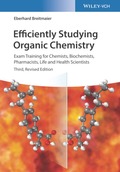Efficiently Studying Organic Chemistry
Exam Training for Chemists, Biochemists, Pharmacists, Life and Health Scientists

3. Auflage April 2022
320 Seiten, Softcover
981 Abbildungen (981 Farbabbildungen)
Lehrbuch
ISBN:
978-3-527-35056-8
Wiley-VCH, Weinheim
Kurzbeschreibung
Ein kompaktes und übersichtliches Lehrbuch für die erfolgreiche Prüfungsvorbereitung und zur Selbstüberprüfung. Der perfekte Begleiter für Bachelor- und Masterstudenten.
Jetzt kaufen
Preis: 48,90 €
Preis inkl. MwSt, zzgl. Versand
Euro-Preise für Wiley-VCH- und Ernst & Sohn-Titel sind nur für Deutschland gültig. In EU-Ländern gilt die lokale Mehrwertsteuer. Portokosten werden berechnet.
Atomic Orbitals, Electronic Configurations
Covalent Bonding
Hybridization of Atomic Orbitals
Covalent Carbon-Carbon Bonding
Alkanes
Skeletal Structure, Structural Isomerism
Basic Rules of Nomenclature
Drawing Molecular Structures
Conformation
Reactive Intermediates
Basic Types of Organic Reactions
Energy Turnover of Chemical Reactions
Radical Substitution
Alkenes, Skeletal and Configurational Isomers
Synthesis of Alkenes
Additions to Alkenes
Dienes
Additions and Cycloadditions with 1,3-Dienes
Alkynes
Cycloalkanes
Basic Syntheses of Cycloalkanes and Cycloalkenes
Reactions of Cycloalkanes and Cycloalkenes
Benzene, Aromaticity, Aromatic Compounds
Benzenoid Aromatic Compounds
Electrophilic Substitution of Benzene
Electrophilic Second Substitution of Benzenes
Other Reactions of Benzenoid Aromatics
Polycyclic Benzenoid Aromatic Compounds
Non-benzenoid Aromatic Compounds
Alkyl Halides
Mechanisms of Nucleophilic Substitution
Organometal Compounds
Alcohols
Diols, Triols
Reactions of Alcohols
Dehydration of Alcohols
Ethers
Amines
Reactions of Amines
Diazo and Azo Compounds
Carboxylic Acids
Carboxylic Acid Derivatives
Substituted Carboxylic Acids
Absolute Configuration
Enantiomers without Carbon as Stereogenic Center
Diastereomers
Aldehydes
Ketones
Carbonyl Reactions
CH Acidity of Carbonyl Compounds
1,3-Dicarbonyl Compounds
Phenols
Quinones
Organosulfur Compounds
Carbonic Acid Derivatives
Heterocumulenes
Rearrangements
Polymers, Polymerization
Syntheses with Organosilicon Compounds
Heteroalicycles
Five-Membered Aromatic Heterocycles
Six-Membered Aromatic Heterocycles
Benzo-Fused Five-Membered Heteroaromatics
Benzo-Fused Six-Membered Heteroaromatics
Fused Aromatic Heterocycles
Absorption of Light, Color, Dyes
Porphyrinoids
Amino Acids
Peptides, Proteins
Alkaloids
Carbohydrates: Aldoses and Ketoses
Carbohydrates: Oligo- and Polysaccharides
Nucleic Acids: DNA and RNA
Lipids
Polyketides
Terpenes
Steroids
Selectivity and Specificity of Organic Reactions
Prochirality, Enantioselectivity
Planning Organic Syntheses
Aspects of Molecular Structure
Mass Spectrometry
Infrared Spectroscopy
Nuclear Magnetic Resonance: Proton NMR
Nuclear Magnetic Resonance: Carbon-13 NMR
Nuclear Magnetic Resonance: Two-Dimensional NMR
NEW: Working on Questions
Subject index
Selected Reference Sources
Periodic Table of the Elements
Covalent Bonding
Hybridization of Atomic Orbitals
Covalent Carbon-Carbon Bonding
Alkanes
Skeletal Structure, Structural Isomerism
Basic Rules of Nomenclature
Drawing Molecular Structures
Conformation
Reactive Intermediates
Basic Types of Organic Reactions
Energy Turnover of Chemical Reactions
Radical Substitution
Alkenes, Skeletal and Configurational Isomers
Synthesis of Alkenes
Additions to Alkenes
Dienes
Additions and Cycloadditions with 1,3-Dienes
Alkynes
Cycloalkanes
Basic Syntheses of Cycloalkanes and Cycloalkenes
Reactions of Cycloalkanes and Cycloalkenes
Benzene, Aromaticity, Aromatic Compounds
Benzenoid Aromatic Compounds
Electrophilic Substitution of Benzene
Electrophilic Second Substitution of Benzenes
Other Reactions of Benzenoid Aromatics
Polycyclic Benzenoid Aromatic Compounds
Non-benzenoid Aromatic Compounds
Alkyl Halides
Mechanisms of Nucleophilic Substitution
Organometal Compounds
Alcohols
Diols, Triols
Reactions of Alcohols
Dehydration of Alcohols
Ethers
Amines
Reactions of Amines
Diazo and Azo Compounds
Carboxylic Acids
Carboxylic Acid Derivatives
Substituted Carboxylic Acids
Absolute Configuration
Enantiomers without Carbon as Stereogenic Center
Diastereomers
Aldehydes
Ketones
Carbonyl Reactions
CH Acidity of Carbonyl Compounds
1,3-Dicarbonyl Compounds
Phenols
Quinones
Organosulfur Compounds
Carbonic Acid Derivatives
Heterocumulenes
Rearrangements
Polymers, Polymerization
Syntheses with Organosilicon Compounds
Heteroalicycles
Five-Membered Aromatic Heterocycles
Six-Membered Aromatic Heterocycles
Benzo-Fused Five-Membered Heteroaromatics
Benzo-Fused Six-Membered Heteroaromatics
Fused Aromatic Heterocycles
Absorption of Light, Color, Dyes
Porphyrinoids
Amino Acids
Peptides, Proteins
Alkaloids
Carbohydrates: Aldoses and Ketoses
Carbohydrates: Oligo- and Polysaccharides
Nucleic Acids: DNA and RNA
Lipids
Polyketides
Terpenes
Steroids
Selectivity and Specificity of Organic Reactions
Prochirality, Enantioselectivity
Planning Organic Syntheses
Aspects of Molecular Structure
Mass Spectrometry
Infrared Spectroscopy
Nuclear Magnetic Resonance: Proton NMR
Nuclear Magnetic Resonance: Carbon-13 NMR
Nuclear Magnetic Resonance: Two-Dimensional NMR
NEW: Working on Questions
Subject index
Selected Reference Sources
Periodic Table of the Elements
Eberhard Breitmaier is emeritus professor at the University of Bonn, Germany. He received his PhD in 1966 at the University of Tübingen, Germany. After a postdoctoral fellowship followed by an appointment as assistant professor for organic chemistry at the University of Houston, Texas, USA, from 1967 to 1968, he gained his lecturing qualification (habilitation) at the University of Tübingen in 1971. He was professor for organic chemistry and instrumental analysis at the University of Bonn from 1975 to 2004. His research focused on 3-alkoxyacroleins as reagents for organic synthesis, porphyrinoid annulenes and natural products. Professor Breitmaier has authored many scientific publications and several textbooks on organic chemistry, NMR spectroscopy, and natural products.


